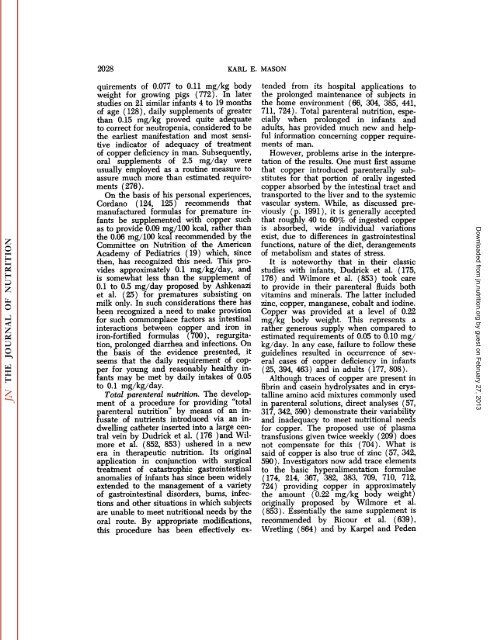conspectus of researchon copper metabolism and requirements
conspectus of researchon copper metabolism and requirements
conspectus of researchon copper metabolism and requirements
Create successful ePaper yourself
Turn your PDF publications into a flip-book with our unique Google optimized e-Paper software.
2028 KARL E. MASON<br />
quirements <strong>of</strong> 0.077 to 0.11 mg/kg body<br />
weight for growing pigs (772). In later<br />
studies on 21 similar infants 4 to 19 months<br />
<strong>of</strong> age ( 128), daily supplements <strong>of</strong> greater<br />
than 0.15 mg/kg proved quite adequate<br />
to correct for neutropenia, considered to be<br />
the earliest manifestation <strong>and</strong> most sensi<br />
tive indicator <strong>of</strong> adequacy <strong>of</strong> treatment<br />
<strong>of</strong> <strong>copper</strong> deficiency in man. Subsequently,<br />
oral supplements <strong>of</strong> 2.5 mg/day were<br />
usually employed as a routine measure to<br />
assure much more than estimated require<br />
ments (276).<br />
On the basis <strong>of</strong> his personal experiences,<br />
Cordano (124, 125) recommends that<br />
manufactured formulas for premature in<br />
fants be supplemented with <strong>copper</strong> such<br />
as to provide 0.09 mg/100 kcal, rather than<br />
the 0.06 mg/100 kcal recommended by the<br />
Committee on Nutrition <strong>of</strong> the American<br />
Academy <strong>of</strong> Pediatrics (19) which, since<br />
then, has recognized this need. This pro<br />
vides approximately 0.1 mg/kg/day, <strong>and</strong><br />
is somewhat less than the supplement <strong>of</strong><br />
0.1 to 0.5 mg/day proposed by Ashkenazi<br />
et al. (25) for prematures subsisting on<br />
milk only. In such considerations there has<br />
been recognized a need to make provision<br />
for such commonplace factors as intestinal<br />
interactions between <strong>copper</strong> <strong>and</strong> iron in<br />
iron-fortified formulas (700), régurgita<br />
tion, prolonged diarrhea <strong>and</strong> infections. On<br />
the basis <strong>of</strong> the evidence presented, it<br />
seems that the daily requirement <strong>of</strong> cop<br />
per for young <strong>and</strong> reasonably healthy in<br />
fants may be met by daily intakes <strong>of</strong> 0.05<br />
to 0.1 mg/kg/day.<br />
Total parenteral nutrition. The develop<br />
ment <strong>of</strong> a procedure for providing "total<br />
Sarenteral nutrition" by means <strong>of</strong> an injsate<br />
<strong>of</strong> nutrients introduced via an in<br />
dwelling catheter inserted into a large cen<br />
tral vein by Dudrick et al. (176 )<strong>and</strong> Wilmore<br />
et al. (852, 853) ushered in a new<br />
era in therapeutic nutrition. Its original<br />
application in conjunction with surgical<br />
treatment <strong>of</strong> catastrophic gastrointestinal<br />
anomalies <strong>of</strong> infants has since been widely<br />
extended to the management <strong>of</strong> a variety<br />
<strong>of</strong> gastrointestinal disorders, burns, infec<br />
tions <strong>and</strong> other situations in which subjects<br />
are unable to meet nutritional needs by the<br />
oral route. By appropriate modifications,<br />
this procedure has been effectively ex<br />
tended from its hospital applications to<br />
the prolonged maintenance <strong>of</strong> subjects in<br />
the home environment (66, 304, 385, 441,<br />
711, 724). Total parenteral nutrition, espe<br />
cially when prolonged in infants <strong>and</strong><br />
adults, has provided much new <strong>and</strong> help<br />
ful information concerning <strong>copper</strong> require<br />
ments <strong>of</strong> man.<br />
However, problems arise in the interpre<br />
tation <strong>of</strong> the results. One must first assume<br />
that <strong>copper</strong> introduced parenterally sub<br />
stitutes for that portion <strong>of</strong> orally ingested<br />
<strong>copper</strong> absorbed by the intestinal tract <strong>and</strong><br />
transported to the liver <strong>and</strong> to the systemic<br />
vascular system. While, as discussed pre<br />
viously (p. 1991), it is generally accepted<br />
that roughly 40 to 60% <strong>of</strong> ingested <strong>copper</strong><br />
is absorbed, wide individual variations<br />
exist, due to differences in gastrointestinal<br />
functions, nature <strong>of</strong> the diet, derangements<br />
<strong>of</strong> <strong>metabolism</strong> <strong>and</strong> states <strong>of</strong> stress.<br />
It is noteworthy that in their classic<br />
studies with infants, Dudrick et al. (175,<br />
176) <strong>and</strong> Wilmore et al. (853) took care<br />
to provide in their parenteral fluids both<br />
vitamins <strong>and</strong> minerals. The latter included<br />
zinc, <strong>copper</strong>, manganese, cobalt <strong>and</strong> iodine.<br />
Copper was provided at a level <strong>of</strong> 0.22<br />
mg/kg body weight. This represents a<br />
rather generous supply when compared to<br />
estimated <strong>requirements</strong> <strong>of</strong> 0.05 to 0.10 mg/<br />
kg/day. In any case, failure to follow these<br />
guidelines resulted in occurrence <strong>of</strong> sev<br />
eral cases <strong>of</strong> <strong>copper</strong> deficiency in infants<br />
(25, 394, 463) <strong>and</strong> in adults (177, 808).<br />
Although traces <strong>of</strong> <strong>copper</strong> are present in<br />
fibrin <strong>and</strong> casein hydrolysates <strong>and</strong> in crys<br />
talline amino acid mixtures commonly used<br />
in parenteral solutions, direct analyses (57,<br />
317, 342, 590) demonstrate their variability<br />
<strong>and</strong> inadequacy to meet nutritional needs<br />
for <strong>copper</strong>. The proposed use <strong>of</strong> plasma<br />
transfusions given twice weekly (209 ) does<br />
not compensate for this (704). What is<br />
said <strong>of</strong> <strong>copper</strong> is also true <strong>of</strong> zinc (57, 342,<br />
590 ). Investigators now add trace elements<br />
to the basic hyperalimentation formulae<br />
(174, 214, 367, 382, 383, 709, 710, 712,<br />
724) providing <strong>copper</strong> in approximately<br />
the amount (0.22 mg/kg body weight)<br />
originally proposed by Wilmore et al.<br />
(853). Essentially the same supplement is<br />
recommended by Ricour et al. (639),<br />
Wretling (864) <strong>and</strong> by Karpel <strong>and</strong> Peden<br />
Downloaded from<br />
jn.nutrition.org<br />
by guest on February 27, 2013
















